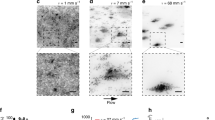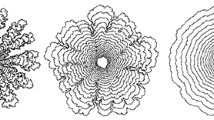Abstract
Several models of microbial surface colonization have been devised to quantitate growth and attachment rates on surfaces. One of these, the surface growth rate equation, is based on the assumption that the number of microcolonies of a given size (Ci) reaches a constant value (Cmax) that is equal to the attachment rate (A) divided by the specific growth rate (Μ). In this study, a computer simulation was used to determine the time required to reach Cmax. It was shown that Ci approaches Cmax asymptotically. The time required is dependent solely upon the growth rate and size of microcolonies. The number of one-celled microcolonies reaches 95% of Cmax after 4.3 generations. At low growth rates, a relatively long incubation period is required. Alternate methods that shorten the incubation time are considered.
Similar content being viewed by others
References
Bott, TL (1975) Bacterial growth rates and temperature optima in a stream with fluctuating thermal regime. Limnol Oceanogr 20:191–197
Bott TL, Brock TD (1970) Growth rate ofSphaerotilus in a thermally polluted environment. Appl Microbiol 19:100–102
Bott TL, Brock TD (1970) Growth and metabolism of periphytic bacteria: Methodology. Limnol Oceanogr 15:332–342
Brannan DK, Caldwell DE (1982) Evaluation of a proposed surface colonization equation usingThermothrix thiopara as a model organism. Microbial Ecology 8:15–21
Brennan RD, deWitt CT, Williams WA, Quattrin EV (1970) The utility of a digital simulation language for ecological modeling. Oecologia (Berl.) 4:113–132
Caldwell DE, Brannan DK, Kieft TL (1982)Thermothrix thiopara: Selection and adaptation of a filamentous sulfur-oxidizing bacterium colonizing hot spring tufa at pH 7.0 and 74 C. Environmental Biogeochemistry Ecol Bull (Stockholm) 35:1–10
Caldwell DE, Brannan DK, Morris ME, Betlach MR (1981) Quantitation of Microbial growth on surfaces. Microbial Ecology 7:1–11
Caldwell DE, Malone J, Kieft TL (1983) Derivation of a growth rate equation describing microbial surface colonization. Microbial Ecology 9:1–6
International Business Machines. (1972) System/360 continuous system modeling program user's manual. Program number 360A-CX-16X
Author information
Authors and Affiliations
Rights and permissions
About this article
Cite this article
Kieft, T.L., Caldwell, D.E. A computer simulation of surface microcolony formation during microbial colonization. Microb Ecol 9, 7–13 (1983). https://doi.org/10.1007/BF02011576
Issue Date:
DOI: https://doi.org/10.1007/BF02011576




